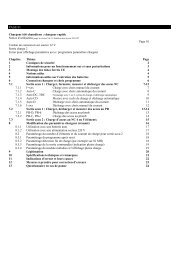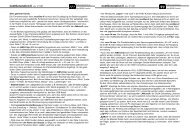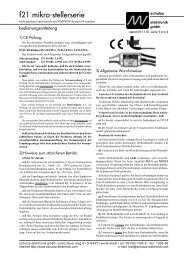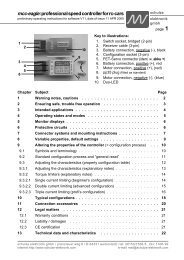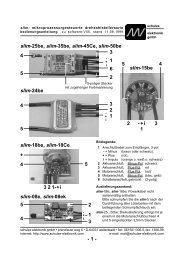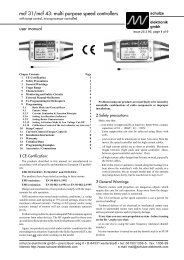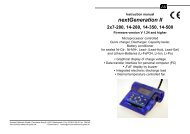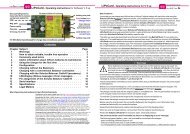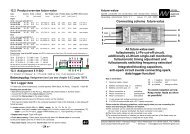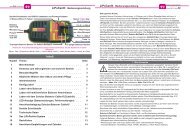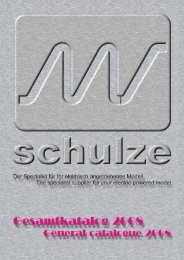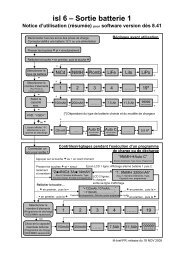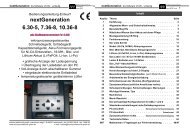nextGeneration II 2x7-280, 14-280, 14-350 - Schulze Elektronik GmbH
nextGeneration II 2x7-280, 14-280, 14-350 - Schulze Elektronik GmbH
nextGeneration II 2x7-280, 14-280, 14-350 - Schulze Elektronik GmbH
Create successful ePaper yourself
Turn your PDF publications into a flip-book with our unique Google optimized e-Paper software.
42<br />
Page Issue 03.10<br />
Operating<br />
instructions<br />
Issue 03.10, page<br />
<strong>nextGeneration</strong> <strong>II</strong> Firmware version V 1.00 and higher<br />
<strong>nextGeneration</strong> <strong>II</strong> Firmware V 1.00 and higher 7<br />
24 Standard ready-made configurations<br />
For your own configurations space for 40 or 60 setups are available - which can be assigned alternatively<br />
from the battery outputs 1 or 2. If you are in the menu for battery 1 you are not able to read setups written<br />
by the battery 2 menu (or the other way round - the name of the configuration is crossed out).<br />
We recommend that you store setups for the battery 2 output from "behind" i.e. beginning with the<br />
last (highest) setup number.<br />
If you have your own ideas about configuration names, or if you wish to alter the order of the configurations,<br />
you can certainly do this exactly as you wish within the limits of the software's facilities. For<br />
example, to copy a particular configuration to a different number, simply read in the configuration<br />
with the old number, then store it under the new number. Only the name has to be altered.<br />
# Outp. Name B.Type Program cCurr [mA] dCurr Quant. Time CutOff<br />
1 1 Po-C3Ah7 Li-Po fix_C 3700 (3700) 4000 90 v-max<br />
2 1 Po-C5Ah0 Li-Po fix_C 5000 (5000) 5500 90 v-max<br />
3 1 Po-CD3A2 Li-Po fix_C 3200 (3200) 3600 90 v-max<br />
4 1 MH-C3Ah6 Ni-MH autoC max. (max.) 5000 120 sensitive<br />
5 1 MH-D3Ah6 Ni-MH autoD (max.) max. (5000) (120) (sensit.)<br />
6 1 MH-CD3A6 Ni-MH autoCD max. max. 5000 120 sensitive<br />
7 1 Cd-C2Ah4 Ni-Cd autoC max. (max.) <strong>280</strong>0 60 normal<br />
8 1 Cd-D2Ah4 Ni-Cd autoD (max.) max. (<strong>280</strong>0) (60) (normal)<br />
9 1 Fe-C1Ah2 Li-Po festL 1200 - 1600 90 v-max<br />
10 1 Pb-C7Ah0 Lead festL 2500 (2500) 7000 300 v-max<br />
Hint: Values in parenthesis are set but not used.<br />
For the battery 2 output all pre-settings are copied in reverse order to the memory:<br />
Using the next-<strong>14</strong>-<strong>350</strong> all values of setting No. 60 (battery 2) are copied from setting No. 1 (battery 1), all<br />
values of setting No. 59 (battery 2) are copied from setting No. 2 (battery 1), e.t.c.<br />
With the next-...-<strong>280</strong> the storage location No. 40 (battery 2) corresponds to the storage location No. 1<br />
(battery 1), the storage location No. 39 (battery 2) corresponds to the storage location No. 2 (battery 1), ...<br />
Addition: All CombinationCycles, C-Rates, CellCounts (except nickel batteries) = 1;<br />
25 Standard setup charge-/discharge programs<br />
Menu output 1 output 2<br />
Battery type ("bType") LiPo LiPo<br />
Charge/discharge program ("prog.") fix_C fix_C<br />
Charge current ("cCurr") 3.00 A 3.00 A<br />
Discharge current ("dCurr") 3.00 A 3.00 A<br />
Cut-off mode ("cutOf") normal normal<br />
Cut-off delay ("delay") 1 minute 1 minute<br />
Cell count ("cells") - can not be configured 2 2<br />
Charge quantity limit ("quan>") 4000 mAh 4000 mAh<br />
Charge time limit ("time>") 60 minutes 60 minutes<br />
Temperature cut off limit ("temp>") OFF OFF<br />
Discharge protection Diode ("diode") NO NO<br />
Refresh (short discharge pulses) ("refr.") OFF OFF<br />
Charger parameters:<br />
Car battery minimum voltage 11.2 V<br />
Temperature 60 °C<br />
Current / power (depends on type of charger) maximum<br />
Full / Empty Light Output Flashing light<br />
Other parameters: All CombinationCycles, C-Rates, CellCounts (except nickel batteries) = 1; lithium-full/<br />
empty-limits as stated in chapter 4 or shown in Fig. 7.5.2.<br />
4.2 Nickel-Cadmium-batteries (Ni-Cd)<br />
Nominal voltage level: 1.2 V / cells.<br />
Selecting the fast charge current (manual setting):<br />
Charge current = 2 C (never less!) (C=nominal battery capacity). Otherwise the cells do not make a<br />
detectable peak and the peak cut off automatic is not able to work resp. to work reliable.<br />
Maximum continous discharge current:<br />
Currents of 10 C to 30 C are possible, depending on cell type.<br />
Long time storage:<br />
Empty i.e. discharged to the discharge voltage cut off level, at low temperature (-20°C to +10°C).<br />
Maintenance: Charging: The automatic current setting circuitry (patent applied for) provides optimum<br />
protection to your Ni-Cd batteries during charging. The reduced current towards the end of the charge<br />
ensures a completely full pack combined with only a slight temperature rise, as you will easily see in<br />
comparison with conventional constant current techniques.<br />
Do not use the automatic charge current calculation of the Ni-Cd batteries when charging Ni-MH batteries!<br />
Discharging: To prevent your cells from memory effect and to keep the full capacity you have to discharge it<br />
after use, even when you store it over night (select Auto-D program to discharge down to 0.85V / cell).<br />
If a battery is brand-new or used irregularly it is often only possible to condition it completely by carrying<br />
out several discharge - charge cycles. Amongst model car operators it is standard practice to erase<br />
any memory effect by completely discharging each cell individually via a resistor (approx. 68 Ohm).<br />
This deliberately ”un-forms” the pack, but it can cause the automatic charge termination circuitry to<br />
switch off the current prematurely during the charge process. Remedy: Discharge with a 10 Ohm<br />
resistor in series to a 1 A diode (1N4001).<br />
For receiver batteries special types such as the Sanyo KR500AAEC / N500AC (high reliable) are a good choice.<br />
Warning: If using reduced charge current with 1-6 cells makes the voltage peak in the charge curve very<br />
slight, especially with batteries of high nominal capacity. In this situation the charger is sometimes<br />
unable to detect the ”full” condition due to the ill-defined peak.<br />
4.3 Nickel-Metal-Hydride batteries (Ni-MH)<br />
Voltage level: 1.2 V / cell.<br />
Selecting the fast charge current manually (not automatically):<br />
Charge current typical 1 C (never less!) (set a fixed current of, for example, 1.2 A with 1100 mAh<br />
batteries, or 3 A with 3 Ah cells). Otherwise the cells do not make a detectable peak and the peak cut<br />
off automatic can not work reliable. Some modern high-current Ni-MH cells made by particular<br />
manufacturers can safely be charged at a higher rate of up to 1.6 C (Panasonic 3000: 3,5 - 4A, GP<br />
3000/3300: 3 A, Saft 3000: 3 A (not if battery is charged inside a transmitter!), Sanyo 3000/3300: 4 - 5A).<br />
Because of its high internal resistance do not charge high capacity cells of mignon(AA)-size from 1500<br />
mAh upward with automatic current calculation (AutoC, -CD, -DC).<br />
Maximum continous discharge current:<br />
Currents of 5 C to 15 C are possible, depending on cell type.<br />
Long time storage:<br />
Store old generation cells empty, (those types which had been available in the SUB-C size up to<br />
3.3 Ah) i.e. discharged to the cut off level (see maintenance), at low temperature (-20°C to +10°C).<br />
The new generation cells should NOT be stored empty - The self discharge rate is too high!<br />
Discharge down to the cut off level (see maintenance) and then charge in about 30% of their<br />
capacity (use the quantity cut off feature). Store all cells at low temperature (-20°C to +10°C).<br />
Maintenance: To protect your Ni-MH batteries from the memory effect and keep the full capacity, discharge the<br />
cells after use down to the discharge voltage limit even when you store it over night and add 30% (new cell<br />
types). Never discharge by car bulbs or the drive motor (premature charge termination!), but use only the<br />
Auto-D programm when the battery type Ni-MH is selected. The cut off voltage is 1 volt / cell. This eliminates<br />
the danger of deep discharge termination and polarity reversal (over-discharge).<br />
It is important that you take the trouble to give Ni-MH cells when storing at +10...30°C a charge /<br />
discharge cycle around every four weeks, otherwise they become tired, and have to be pampered.



